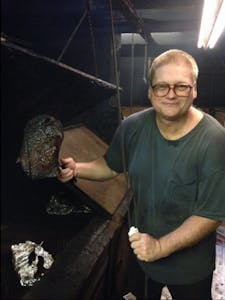 Owner/Pitmaster: Martin’s Place; Opened 1925 (current location 1939)
Owner/Pitmaster: Martin’s Place; Opened 1925 (current location 1939)
Age: 57
Smoker: Indirect Heat Wood-Fired Pit
Wood: Oak
A Kapchinskie has been cooking barbecue at Martin’s Place in Bryan, Texas since 1925. That makes it older than Black’s BBQ in Lockhart and just as old as Prine’s BBQ in Wichita Falls. Today, it’s still a family affair. Steve Kapchinskie has been manning the pits for forty-five years. He married his wife Betty thirty-seven years ago, and she has worked the front counter at Martin’s Place since 1999. Now, their daughter Mandy is also on staff.
Martin’s Place is one of few barbecue joints with a marker out front from the Texas Historical Commission. It’s a Texas Treasure that is nearly ninety years old, and that is worth celebrating.
Steve and I spoke in the pit room at Martin’s Place. The air in there is hot and almost completely still. Steve spends up to thirteen hours per day in the room. I was sweating and uncomfortable after just thirty minutes, but talking to Steve about his life’s work in the room where it has all happened was easily worth it.
Daniel Vaughn: When did this place open?
Steve Kapchinskie: My grandfather started on the corner in a wooden building in 1925. You can still see the bricks in the parking lot. He had an in-the-floor brick pit. He sold gas. It was like a little grocery store.

DV: And your grandfather’s name?
SK: Martin Kapchinskie. That’s where Martin’s comes from. Kapchinskie’s would have made a big old sign. He had an outdoor pit that he used for weddings. That was in the late twenties and early thirties. That was a big pit. Twice as big as this one [pointing to the brick pit used daily]. It was in a ship-lap wooden building. His first employee was an old black gentleman named Henry. He tended the pits. His grandchildren still come here. They remember their grandfather working here.

DV: When was this building built?
SK: In 1939 they tore that one down and built this one.
DV: So the business has been in this building since 1939, but you’ve been in business since 1925, correct?
SK: Right. This is the seventy-fifth anniversary of this building and this pit.
DV: Did Martin build this building?
SK: Yes. Well, do you know the Varisco Building in downtown Bryan? That same company built this building. The contractor was O. Lee Martensen. It’s an old double-wall brick building. They don’t build them like this anymore.
Steve had to pause our interview to get an order of brisket sliced for a customer.
SK: So I suppose you’ve been over to Lockhart.
DV: I have.
SK: Kreuz is coming here.
DV: I heard. Any thoughts about that?
SK: Well, I still have my customers. They go to the other local barbecue joints here with the ovens, and they always come back. That’s all electronic. This isn’t. I don’t use any chemicals either. I start my fire with boxes. The chimney is the secret. Without that chimney there’d be no draw and it wouldn’t cook. The taller the chimney, the greater the draw.
DV: What about this other pit [there’s a second brick pit in the pit room]?
SK: This whole area was added ten years later.
DV: Business must have been good then?
SK: Oh yeah. He had all the catering around here. I’ll use the big pit on Friday.
DV: The second pit is just for weekends?
SK: Yes. I can cook on about two-thirds of it.
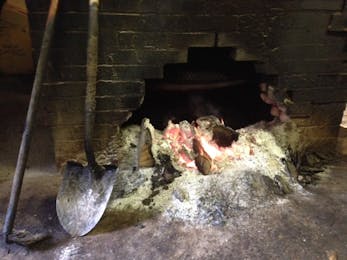
DV: Down near the end it gets right overtop the fire, so I guess you can cook with direct heat too.
SK: Yeah. I gotta watch it. I rotate because that direct heat will burn up that meat and crisp the outside. Of course you want it a little crispy, but you don’t want a burnt taste. If that starts happening, I wrap it in foil.
DV: Do you do that with all your briskets?
SK: Not really. When you wrap it with foil the meat starts to steam, and you lose your flavor. Any time you steam something the flavor comes out. I did it on a piece of meat today that wasn’t acting right. With a pit that doesn’t have a thermostat or electronics, you gotta know your hot and cold spots, but every day is a different cook. It all depends on the barometric pressure. When you’re depending on this draw, you’re at the mercy of Mother Nature.
DV: So the air literally gets heavy?
SK: Oh yeah, The fire just zzzz. I’ve just got to find the hot spot. Eighty percent of the time it goes just fine.
DV: Back to the business, how long did Martin run this place?
SK: Well, my dad went into the service. When he came back they opened a meat market in 1946. They added a walk-in cooler so they could sell raw meat. Actually, back when it opened in ’39 it was a café. They had eggs and goose liver on toast for $0.25. T-bones were $0.45. [Find copies of the old menu in another post.]
DV: When it was a café I’m guessing you still had barbecue.
SK: Right.
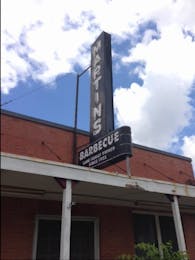
DV: This must’ve been one of just a few places to eat around here back then.
SK: We were midway between Bryan and College Station. When the farmers would go to Bryan to get their goods for the week, they would stop in my grandfather’s store and get their supplies on the way back to their farms.
DV: Back then, was downtown Bryan the place to be?
SK: Right. This was all farms. Later when they had vehicles, my dad would pump red lead East Texas gas. I wish I had one of those old pumps.
DV: How long did the meat market run?
SK: Until the sixties when everything had to be stainless. They just didn’t think it was worth it anymore with all the regulations. My granddad moved to Michigan. He retired, and my dad went to straight barbecue. He came back in 1971 because he had diabetes. He passed away here in 1971.
DV: How long did your dad run the place?
SK: Until 1976 when he died of throat cancer. I had just graduated high school. I was thinking about going to Blinn [College]. I was going to take business or something. I had helped him since I was twelve.
DV: What was your father’s name?
SK: Albin. They called him “Bean” because he was tall and skinny. I got my size from my grandpa Martin.
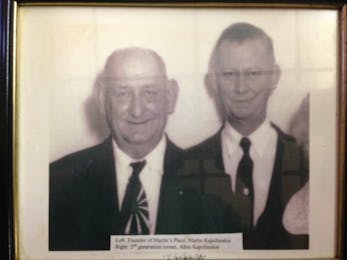
DV: But you work plenty of it off back here working in the heat.
SK: Oh yeah. Some days I lose six or eight pounds. It’s hot.
DV: I hope you’ve got plenty to drink back here.
SK: Try to. The doctor tells me I’m going to pass out into the pit one day. He says “you’re going to burn everything up including yourself,” so he’s trying to keep me as hydrated as possible. I drink six or eight cups of water and I drink Powerade. Last year I was told to get Pedialyte. I’m fifty-seven now, so he reminds me that I’m not twenty-seven anymore. He was one of my high school buddies. He was my trainer when I played football.
DV: So he’s still keeping you healthy?
SK: Yeah.
DV: So when did you take over the business?
SK: My dad walked in and said “son, I’ve got to go to Temple. They want to cut my throat open. Here you go.” He handed me the keys.
DV: Not exactly a grand succession plan.
SK: I had a business thrust upon me, and I had just turned nineteen. He didn’t do anything here when he got back from the hospital and he died in 1980. That’s when I took over the ownership. I’ve owned it for thirty-four years, but I’ve worked here for forty-five years.
DV: Because of your father’s health, you’ve been doing this a whole lot longer than he got to.
SK: Oh yeah. Let’s see. My grandfather was born in 1890. He was a butcher in Marlin before he came here. He moved here in 1924 and bought this place. He ran it for forty-one years, so I’ve got them both beat. Hopefully I can go ten more.

DV: Well, we all hope for that. What all have you changed since you’ve worked here? What did the barbecue menu look like back then. Was it brisket?
SK: From what I remember it was just brisket. I don’t remember having anything but beef. We had no fried foods. Of course it was at least fifty percent beer back then. There were a bunch of men who played dominoes, but they’re all gone now. Now we don’t do but ten percent beer.
Betty Kapchinskie: We added air conditioning in 1985.
SK: And we took the pool table out. We added all new tables, and replaced the windows up front. My sister’s husband put in the drop ceiling. They covered up a really nice tin ceiling. It’s still up there.. You see, my mother died the week before my grandfather did. My dad lost his wife and his dad in one week’s time. That kinda hit him hard. All of sudden he was changing everything. I guess he was trying to get rid of memories.
DV: If you were cooking briskets, do you remember if they were cooking anything different on the pits before then?
SK: Oh, they cooked the whole calf. That’s when the meat market came in. I remember cutting up whole roasts. We’d cut beautiful T-bones. They didn’t know what brisket was. It was scrap beef. So were the fajitas. The skirt meat – they called it “saddle blanket” and they threw it away.
DV: Do you remember went you started cooking briskets?
SK: My dad was still here, so I think it was ’72, maybe ’73.
DV: Before that, were you cooking the entire animal, or just the forequarter?
SK: The whole thing. T-bones, sirloins. All of it.
DV: What would people order? Just beef barbecue?
SK: Yeah. That was it.
DV: How did you determine what to serve. Did you just cut it all up as you went?
SK: Yeah.
DV: Was it sliced or chopped?
SK: Sliced. You might cut it out of the T-bone. They were beautiful. The rounds were a little dry, but nobody complained. Now they’ll tell you if it’s dry.
DV: Did anyone request lean or fatty beef?
SK: No, but now they all want the marbled end. To me, that’s what I prefer too because that’s where all the flavor is. You gotta have the fat.
DV: What do you season with?
SK: Actually, it’s fajita seasoning. I get it locally from Ruffino’s. I’ve been dealing with them for forty years. I sprinkle it on both sides and rub it in. But back then my grandfather used just salt. Not the fine stuff either. It was the bagged salt. He said “we don’t want to ruin the good flavor of the meat with all that.”
DV: Would he think you’re ruining it with the fajita seasoning?
SK: I don’t know if they’d like that or not, but I just wanted to add a little pepper.
DV: You said you’d been working here for a while before you took over the business, but did you really know what you were doing back here when your dad handed you the keys?
SK: Oh yeah. I worked all the time with my dad.
DV: Who worked the front of the house back then?
SK: Kay, my great uncle. He started working here in ’46 and worked until ’87 when he died. We called him Uncle Steve. He remembered what beer everyone wanted and what kind of food they wanted.
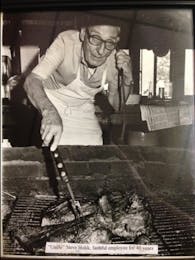
DV: But this back here has been your domain?
SK: That’s right. When I’m cooking and it’s hot, I don’t really like to cool off. I want to stay one or the other. I don’t have a fan because it would only blow hot air. I suffer along with the briskets. While they’re cooking, I’m cooking.
DV: It’s a little less smoky in here now than last time I was here.
SK: I’m almost through for the day, so I’m cooling it down,
DV: Do you worry about your health sitting back here with all of the smoke?
SK: Yeah, but the doctor says I’m doing alright. All this char back here though…if it does that to the wood…
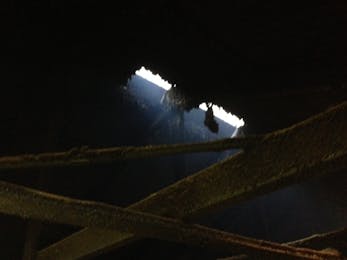
DV: What is your daily routine? When do get here in the morning?
SK: I can’t get here at midnight and work until seven the next evening. I have to cook them some and wrap them. I get them almost finished then put them on in the morning. I can’t be like Franklin Barbecue and cook them all night. I’m just me. But you know, Aaron Franklin used to come in here with his grandpa.
DV: When do you get here?
SK: I try to get here by 6:30, but sometime I have to start at 3:00 if I have a big order. That’s mainly on Saturdays.
DV: When do you get to leave?
SK: On Fridays, I stay until 8:00.
DV: That’s a long day.
SK: Fourteen hours of sweating.
Steve hands me the corner cut from the flat off a fresh brisket. It’s one of the finer bites of brisket I can remember with the perfect balance of fat to meat and an overt smoky and salty rush from all that blackened surface area.
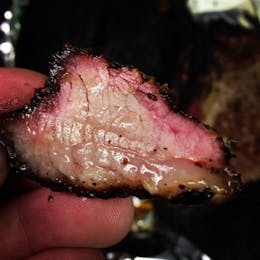
DV: Is this cutting board where you cut every order?
SK: Right. I used ot have a wooden block, but it got bad and [the Health Department] made me get rid of it. It had too many nicks and cracks and it was not cleanable. One of these boards last me about three months.
DV: How long have you had this cleaver?
SK: A good while. I’d say twenty-five years at least.
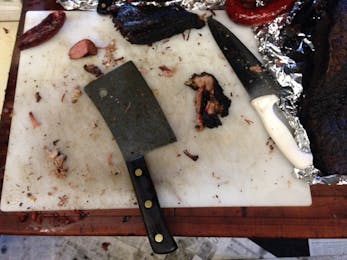
DV: This place was started by your grandfather, then passed down to your father, then you. Who’s next?
SK: My daughter, Mandy. I’ll help her as long as I can, but not too many people can do this work. She can cook. My son, he’s a CPA, so he’s not interested
DV: He gets to sit in the air conditioning there, and I don’t blame him. I’ve been back here for twenty minutes and I’m covered in sweat.
SK: This is a mild day. A month from now it’ll be right here [pointing to the 118 degree mark on the large, wall-hung thermometer].
DV: How much meat do you go through in a week?
SK: About four hundred pounds of brisket. I don’t break any records, but it keeps me busy.
DV: And you suffer back here with all of it.
SK: All of us got heat exhaustion last year [they closed an extra day every week for a few weeks to give Steve and extra day of rest].
DV: That’s some real dedication to the barbecue craft.
SK: Oh, I’ve put my tough days in. Believe me, there are some days that I can’t even move when I get out of here. Things just get so bad with the heat I get exhausted, but I got up and did it again the next day.







